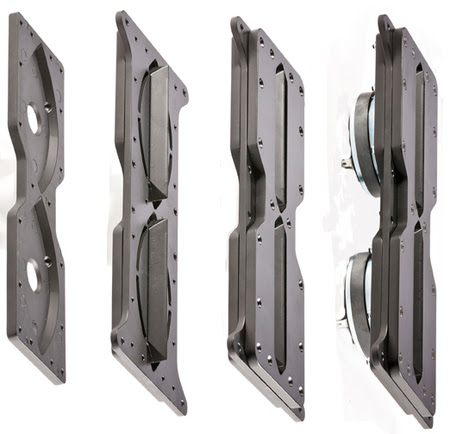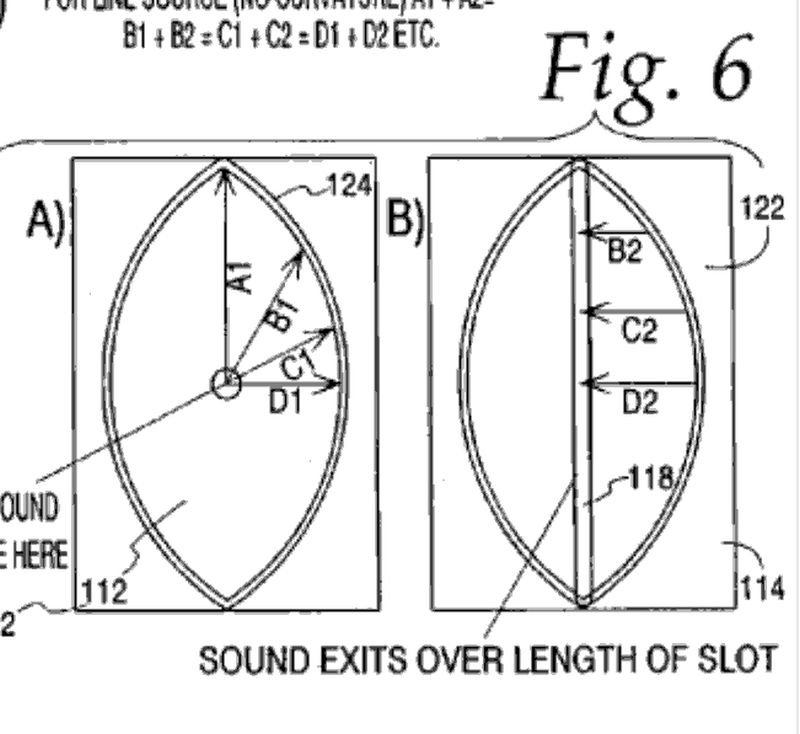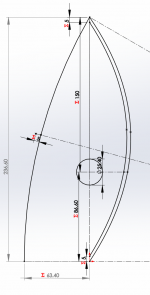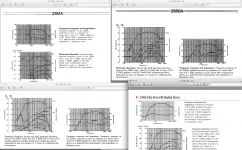The Paraline has been a frustrating project for me, because it seems to have so much potential, and it's so elegant, but the frequency response is just so ugly.
And I've tried SO many things to make the response better:
1) I've tried improving my construction technique
2) I've tried painting the inside, to smooth the surface, as Danley mentioned that a rough surface would reduce SPL
3) I've tried big Paralines
4) I've tried ribbons
5) I've tried domes
6) I've tried compression drivers
7) I've tried small Paralines
8) I've tried alternate geometries, like my 'Squar-a-line' and my half-a-para-line named 'Stargate.'
Nothing seemed to make a difference.
But a huge light bulb just went off over my head, based on a comment that JLH made.
JLH noted that the spl output of the Jericho J3 is probably 'obscene'.
And I was going to chime in, because I've noticed that the output level of the conventional Synergy horns are close especially if they have narrow coverage.



But you can't have your cake and eat it too; the wide angle synergy horns have smoother frequency response. The narrower the angle is, the worse the frequency response is.
Long story short - perhaps the ragged frequency response has as much to do with the coverage angle as the reflector. Perhaps very narrow angle horns are naturally rougher in response than wide angle horns.
This is something I've noticed from measuring dozens of waveguides and horns, but I'd never stopped to think that it would happen in a Paraline. But of course it will! A Paraline is still a horn after all, albeit one with a an unorthodox phase plug.

The effect of widening the coverage angle isn't exclusive to Synergy horns; for instance this measurement of a Geddes waveguide, with 90 degrees of coverage, demonstrates very smooth frequency response with a wide coverage angle. (Except for the infamous on-axis dip, which is inescapable due to the symmetrical geometry of the mouth.)
And I've tried SO many things to make the response better:
1) I've tried improving my construction technique
2) I've tried painting the inside, to smooth the surface, as Danley mentioned that a rough surface would reduce SPL
3) I've tried big Paralines
4) I've tried ribbons
5) I've tried domes
6) I've tried compression drivers
7) I've tried small Paralines
8) I've tried alternate geometries, like my 'Squar-a-line' and my half-a-para-line named 'Stargate.'
Nothing seemed to make a difference.
But a huge light bulb just went off over my head, based on a comment that JLH made.
JLH noted that the spl output of the Jericho J3 is probably 'obscene'.
And I was going to chime in, because I've noticed that the output level of the conventional Synergy horns are close especially if they have narrow coverage.



But you can't have your cake and eat it too; the wide angle synergy horns have smoother frequency response. The narrower the angle is, the worse the frequency response is.
Long story short - perhaps the ragged frequency response has as much to do with the coverage angle as the reflector. Perhaps very narrow angle horns are naturally rougher in response than wide angle horns.
This is something I've noticed from measuring dozens of waveguides and horns, but I'd never stopped to think that it would happen in a Paraline. But of course it will! A Paraline is still a horn after all, albeit one with a an unorthodox phase plug.

The effect of widening the coverage angle isn't exclusive to Synergy horns; for instance this measurement of a Geddes waveguide, with 90 degrees of coverage, demonstrates very smooth frequency response with a wide coverage angle. (Except for the infamous on-axis dip, which is inescapable due to the symmetrical geometry of the mouth.)
John,The Paraline has been a frustrating project for me, because it seems to have so much potential, and it's so elegant, but the frequency response is just so ugly.
Long story short - perhaps the ragged frequency response has as much to do with the coverage angle as the reflector. Perhaps very narrow angle horns are naturally rougher in response than wide angle horns.
Narrow angle horns are not naturally rougher in response than wide angle horns. No perhaps, not.
My 13 degree Maltese conical horn has a very smooth response, the same driver on a 90 degree Paraline has ragged response.
I have posted the comparison several times before in your parallel universe of perverse posts, you seem to forget and repeat the same false conclusion repeatedly
Putting large port holes in a narrow horn cause more HF ripple than a wide angle horn simply because the area of interference is larger in relationship to the horn wall area.
Art
The Paraline has been a frustrating project for me, because it seems to have so much potential, and it's so elegant, but the frequency response is just so ugly.
Just goes to show that "looking" elegant is not the same as "being" elegant. Looks can be deceiving.
Patrick,
Trust me on this one, you CAN NOT get decent freq reponse without all the grass out off a paraline. I've BEM modeled and measured a lot of them (also original danleys) and they are all the same; a lot of grass.
The only comparable design which does work is the L'acoutics DOSC waveguide which, if you take a good close look , is the same as a paraline but the stretched out (paraline is a flattened DOSC)
If you bem model a DOSC waveguide, you see that it works very well until you make it to flat, (and the sound has to bend around too sharp corners) then you get the grass
Problem is that it's nearly impossible to DIY a DOSC waveguide, sorry, can't eat your cake again...
I have a lot of respect for Tom Danley, but after a lot of research I only can conclude that his statement about sound bending around sharp corners if the openings are small enough is simply not true.
Kees
Trust me on this one, you CAN NOT get decent freq reponse without all the grass out off a paraline. I've BEM modeled and measured a lot of them (also original danleys) and they are all the same; a lot of grass.
The only comparable design which does work is the L'acoutics DOSC waveguide which, if you take a good close look , is the same as a paraline but the stretched out (paraline is a flattened DOSC)
If you bem model a DOSC waveguide, you see that it works very well until you make it to flat, (and the sound has to bend around too sharp corners) then you get the grass
Problem is that it's nearly impossible to DIY a DOSC waveguide, sorry, can't eat your cake again...
I have a lot of respect for Tom Danley, but after a lot of research I only can conclude that his statement about sound bending around sharp corners if the openings are small enough is simply not true.
Kees
Patrick,
Trust me on this one, you CAN NOT get decent freq reponse without all the grass out off a paraline. I've BEM modeled and measured a lot of them (also original danleys) and they are all the same; a lot of grass.
The only comparable design which does work is the L'acoutics DOSC waveguide which, if you take a good close look , is the same as a paraline but the stretched out (paraline is a flattened DOSC)
If you bem model a DOSC waveguide, you see that it works very well until you make it to flat, (and the sound has to bend around too sharp corners) then you get the grass
Problem is that it's nearly impossible to DIY a DOSC waveguide, sorry, can't eat your cake again...
I have a lot of respect for Tom Danley, but after a lot of research I only can conclude that his statement about sound bending around sharp corners if the openings are small enough is simply not true.
Kees
1989! Wow I was still in high school when this was invented. I haven't seen this:


^^^ it's hard to see the DOSC waveguide in this pic, but you can see a bit of it


^^^ DOSC at top, Paraline at bottom
An externally hosted image should be here but it was not working when we last tested it.

^^^ DOSC at top, Paraline at bottom
Here's the patent. https://www.google.com/patents/US5163167
Is Christian Heil (who invented this) related to Oskar Heil (who invented the air motion transformer ribbon?)
Just goes to show that "looking" elegant is not the same as "being" elegant. Looks can be deceiving.
Something interesting happened with my latest Synergy horn:

My new project uses a coax at the throat, instead of four midranges and a compression driver. Because I'm using a coax, there's no midrange taps, like you would see in a Danley SH-50 or a Sound Physics Labs SPL-TD1.
I had the speaker playing most of the day on Monday, and noticed that I was shouting over the speaker. IE, the speaker SEEMED to be playing at a reasonable level, but every time I tried to say something to someone in the room I found I had to shout.
This was very interesting, as this is something I'd noticed with your Summas. That there's something unusual about the Summa, that it doesn't "sound" loud, even when playing at very high volume.
I don't know if this is low power compression, low HOMs, both, or something else.
But it was startling that this was happening, as I've never noticed it before. IMHO this may lend credence to your theory that those midrange taps generate HOMs via diffraction. Now if only there was a way to reliably measure it
V Dosc line arrays are now more than 20 years old, you may not have seen the patent before, but you have heard plenty of them.1989! Wow I was still in high school when this was invented. I haven't seen this:
John,
Narrow angle horns are not naturally rougher in response than wide angle horns. No perhaps, not.
My 13 degree Maltese conical horn has a very smooth response, the same driver on a 90 degree Paraline has ragged response.
I have posted the comparison several times before in your parallel universe of perverse posts, you seem to forget and repeat the same false conclusion repeatedly.
Putting large port holes in a narrow horn cause more HF ripple than a wide angle horn simply because the area of interference is larger in relationship to the horn wall area.
Art
In my experience, narrow angle horns have rougher response than wide angle horns.
Then again, my experience is limited.
If you're narrow angle horn is smooth, it doesn't prove that they wouldn't be *smoother* if you widened the wall angle.
But there's an easy way to get some good data:
I'll put the same compression driver on three different horns and measure it.
Stay tuned.
Also, hooray for vacation!
The "something else" is simply "temporary threshold shift", which will result in loud sound seeming to be at a "reasonable level", especially after "playing most of the day".I had the speaker playing most of the day on Monday, and noticed that I was shouting over the speaker. IE, the speaker SEEMED to be playing at a reasonable level, but every time I tried to say something to someone in the room I found I had to shout.
I don't know if this is low power compression, low HOMs, both, or something else.
Your coax waveguide, though still having very ragged frequency response (not a whole lot worse than the raw driver), is much smoother than most of your other attempts, and probably also less fatiguing.
Sorry, I don't thinks it's as simple as that. I've listened to a lot of horns and I can count on one hand the ones that can be listened to for hours at high SPL without sounding fatiguing.
I've had people offer to buy my Summa's, and I've passed on the offers. Although I wish they were smaller they are very very easy on the ears.
I've had people offer to buy my Summa's, and I've passed on the offers. Although I wish they were smaller they are very very easy on the ears.
John,In my experience, narrow angle horns have rougher response than wide angle horns.
Then again, my experience is limited.
If you're narrow angle horn is smooth, it doesn't prove that they wouldn't be *smoother* if you widened the wall angle.
But there's an easy way to get some good data:
I'll put the same compression driver on three different horns and measure it.
Your limited experience has been with extremely poorly made narrow horns, their poor manufacture compounded by putting holes in their throats.
The narrow horn expansion profile you emulated does not have the ragged response you found in your horn.
Unless you test three horns of the same style, differing only in dispersion, your test won't be "an easy way to get some good data".
If you simply take the time to compare frequency response charts of JBL, EV, or any number of manufacturers that make a "family" of horns in different beamwidths, you will find how limited your experience is.
Happy Holidays!
I don't see a connection between angle and smoothness. It all has to do with how you handle the mouth. A narrow horn needs to be very deep to work right and most people are unwilling to do this. So they make it short with a small mouth and usually poor flaring. Then it works bad.
Kees,
That's interesting! How do your BEM models compare to the measurements? Is there any chance you could do a tutorial? (abec3?)
The Bem models compare very well with the measurments when you make the resolution fine enough (takes my very fast computer +- 18hours to calculate 1 paraline/dosc).
I'm sorry, can't do a tutorial or post results, since I did all this work for a paying customer and he doesn't want me to commuity share the results. (I did this for a research traject comparing all options which are out there to make a "cylindrical waveform from a compression driver).
I can share the final conclusion though;
The DOSC is, untill now, the "best" approach (lowest distortion, best cyclindrical wavefront, smoothest freq response.)
Also, check out the BMS4512, very capable for the pupose..
Kees
Unless you test three horns of the same style, differing only in dispersion, your test won't be "an easy way to get some good data".
Hi Art
But isn't this impossible? Something has to be different in the size; longer, or smaller mouth, something. They can't be "the same size" and "differ only in directivity" at the same time.
This is a real pet-peeve of mine when people do comparisons of an OSWG with other horns. How do you compare a CD waveguide with a horn that is not? There simply isn't a way to compare them - they are different things.
The Bem models compare very well with the measurments when you make the resolution fine enough (takes my very fast computer +- 18hours to calculate 1 paraline/dosc).
I'm sorry, can't do a tutorial or post results, since I did all this work for a paying customer and he doesn't want me to commuity share the results. (I did this for a research traject comparing all options which are out there to make a "cylindrical waveform from a compression driver).
I can share the final conclusion though;
The DOSC is, untill now, the "best" approach (lowest distortion, best cyclindrical wavefront, smoothest freq response.)
Also, check out the BMS4512, very capable for the pupose..
Kees
I'll post a thread with some info on how to do BEM modeling, if you'd be interested in chiming in, that would be great!
Looks to be a powerful tool, and I wouldn't want the info buried in a thread that's specifically about Paralines
Here's the link: http://www.diyaudio.com/forums/multi-way/247717-free-bem-solver.html#post3744559
Last edited:
Originally Posted by weltersys
Unless you test three horns of the same style, differing only in dispersion, your test won't be "an easy way to get some good data".
In a conical or OS type of waveguide, one could compare units with the same mouth size, with various wall angles, which of course would result in different depths.
As we have mentioned, there won't be a (direct) connection between angle and smoothness.
Looking at the JBL 2380 series of diffraction horns, all of which are the same frontal size and depth, other than the much deeper 2386 40 x 20, we can see that dispersion angle is not an indicator of smoothness.
If anything, the narrower dispersion 2380 horns are smoother.
Art
Unless you test three horns of the same style, differing only in dispersion, your test won't be "an easy way to get some good data".
Earl,Hi Art
But isn't this impossible? Something has to be different in the size; longer, or smaller mouth, something. They can't be "the same size" and "differ only in directivity" at the same time.
This is a real pet-peeve of mine when people do comparisons of an OSWG with other horns. How do you compare a CD waveguide with a horn that is not? There simply isn't a way to compare them - they are different things.
In a conical or OS type of waveguide, one could compare units with the same mouth size, with various wall angles, which of course would result in different depths.
As we have mentioned, there won't be a (direct) connection between angle and smoothness.
Looking at the JBL 2380 series of diffraction horns, all of which are the same frontal size and depth, other than the much deeper 2386 40 x 20, we can see that dispersion angle is not an indicator of smoothness.
If anything, the narrower dispersion 2380 horns are smoother.
Art
Attachments
- Home
- Loudspeakers
- Multi-Way
- Square Pegs

